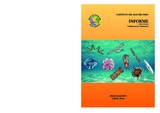Por favor, use este identificador para citar o enlazar este ítem:
https://hdl.handle.net/20.500.12958/2973Registro completo de metadatos
| Campo DC | Valor | Lengua/Idioma |
|---|---|---|
| dc.contributor.author | Salazar Céspedes, Carlos Martín | - |
| dc.contributor.author | Chacón Nieto, Germán | - |
| dc.contributor.author | Alarcón Vélez, Julio | - |
| dc.contributor.author | Luque Sánchez, Carlos | - |
| dc.contributor.author | Cornejo Urbina, Rodolfo | - |
| dc.contributor.author | Chalking, Frank | - |
| dc.date.accessioned | 2016-03-10T19:07:13Z | - |
| dc.date.available | 2016-03-10T19:07:13Z | - |
| dc.date.issued | 2015 | - |
| dc.identifier.citation | Inf Inst Mar Perú 42(2), 2015. p. 185-219 | es_ES |
| dc.identifier.other | 0378 7702 | - |
| dc.identifier.uri | https://hdl.handle.net/20.500.12958/2973 | - |
| dc.description | p. 185-219 | es_ES |
| dc.description.abstract | Los problemas críticos de la pesquería de arrastre de menor escala, son las capturas de ejemplares juveniles, alta presencia de descartes, pesca incidental o accesoria y conflictos con los pescadores artesanales que usan redes de enmalle cortineras. En toda la zona de estudio, los índices de captura por unidad de esfuerzo (CPUE) fue 142,4 kg/h y 477,5 kg/lance, bycatch por unidad de esfuerzo (BPUE) fue 27,2 kg/h y 91,1 kg/lance. Los mayores CPUE fueron en la zona sur dentro de las 5 mn con 199,0 kg/h y 617,8 kg/lance. La composición de la captura relativa al peso estuvo dominada por el falso volador (Prionotus stephanophrys, 24,6%) y carajito (Diplectrum conceptione, 21,4%). Las especies incidentales más importantes fueron espejo (Selene peruviana, 9,8%), bereche (Larimus pacificus, 9,3%), cachema (Cynoscion analis, 4,0%), chiri (Peprilus medius, 2,9%), lenguado de boca chica (Etropus ectenes, 2,5%), doncella (Hemanthias peruanus, 2,1%). El descarte fue 19,1% de la captura, los principales recursos fueron merluza (Merluccius gayi peruanus, 39,1%), lengüeta (Symphurus sechurae, 10,9%), morena (Muraena clepsidra, 4,9%), pez hojita (Chloroscombrus orqueta, 4,8%), otras especies 31,5% (incluyendo restos de peces y equinodermos). El índice de impacto al ecosistema marino fue de 3,7 (1: no favorable al 10: favorable). Por lo que es un arte de pesca no amigable con el ecosistema marino que no debe usarse dentro del área costera | es_ES |
| dc.description.abstract | ABSTRACT: The problems of the trawl fishery of smaller scale, are the catch of juveniles, high presence of discards, bycatch and conflicts with gill nets artisanal fishermen. The total index catch per unit effort (CPUE) and bycatch per unit effort (BPUE) for the study area were 142.4 kg/h and 27.2 kg/h; and 477.5 kg/haul and 91.1 kg/haul respectively. The highest CPUE in the south part were inside of 5 nm to 199.0 kg/h and 617.8 kg/haul. The composition of the total catch on weight was dominated by objective capture the searobin (Prionotus stephanophrys, 24.6%) and sand-perch (Diplectrum conceptione, 21.4%). The incidental species more important were moonfish (Selene peruviana, 9.8%), pacific drum (Larimus pacificus, 9.3%), Peruvian weakfish (Cynoscion analis, 4.0%), Pacific harvestfish (Peprilus medius, 2.9%), sole flounder (Etropus ectenes, 2.5%), rose thread-tail bass (Hemanthias peruanus, 2.1%), among others. Discard represented 19.1% of the total catch, among the main resource was Peruvian hake (Merluccius gayi peruanus, 39.1%), darkcheek tonguefish (Symphurus sechurae, 10.9%), moray (Muraena clepsydra, with 4.9%), Pacific bumper (Pacific bumper, 4.8%) and other species (including fish remains and echinoderms) with 31.5%. The value of impact to the marine ecosystem was 3.7 (1: unfavorable 10: favorable). So it is a fishing gear not friendly to the marine ecosystem should not be used within the coastal area. | - |
| dc.description.sponsorship | Instituto del Mar del Perú | es_ES |
| dc.language.iso | spa | es_ES |
| dc.publisher | Callao | es_ES |
| dc.relation.ispartofseries | Informe IMARPE;Vol. 1, N° 1-4, 2015 | - |
| dc.rights | info:eu-repo/semantics/openAccess | es_ES |
| dc.rights.uri | https://creativecommons.org/licenses/by/4.0/ | - |
| dc.source | Instituto del Mar del Perú - IMARPE | es_ES |
| dc.source.uri | Repositorio Digital IMARPE | es_ES |
| dc.subject | Arrastre De Fondo | es_ES |
| dc.subject | Tumbes | es_ES |
| dc.subject | Flota De Arrastre | es_ES |
| dc.subject | Pesca De Arrastre | es_ES |
| dc.title | Flota de arrastre de fondo de menor escala en la Región Tumbes | es_ES |
| dc.title.alternative | Trawl fishery of small scale in the Tumbes Region | es_ES |
| dc.type | info:eu-repo/semantics/article | es_ES |
| Aparece en las colecciones: | Informe vol. 42(2) 2015 | |
Ficheros en este ítem:
| Fichero | Descripción | Tamaño | Formato | |
|---|---|---|---|---|
| INFORME VOL 42 (2)-7.pdf | 33,8 MB | Adobe PDF |  Visualizar/Abrir |
Este ítem está sujeto a una licencia Creative Commons Licencia Creative Commons

